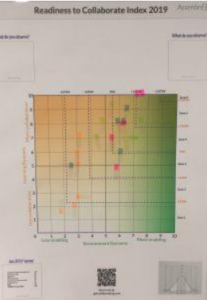Roundtable with Rod Willis
Rod is an APECS Accredited Executive Coach, Windsor Leadership Trust Leadership Facilitator, Agile Business Consortium’s Strategy & Leadership Stream member and Co-founder of Assentire Ltd, Accelerating Collaboration Everywhere®.
Rod opened the session by sharing where in Project 13, there are multiple references highlighting the importance of both an enabling Environment Dynamic and effective Collaborative working, emphasising these are both required to enable the desired shift ‘From Transactions to Enterprises’ which is the name of the ICE report referenced. A few of the highlights are listed below:
- Effective organisation: One of the most surprising conclusions to emerge from the consultations with suppliers was how often collaborative teams are hampered by poor organisation. (*1P21)
- We are embracing the creation of value-driven, collaborative teams that can deliver investment programmes that secure the outcomes demanded by clients and the public. (*1P2.1)
- Too often the supply chain that delivers our infrastructure seems locked into a cycle of low margins, low investment and dysfunctional relationships. (*1P2.2)
- Three stages of maturity: It takes time for organisations to move away from the traditional approach and evolve into high-performing shared enterprises. Our studies of projects show that as collaborations mature, the partners become less reliant on the contracts between them and more skilled at managing their combined resources to produce the required outcomes. (1*P16)
- Effective teams are networks of collaborative relationships that encourage an exchange of knowledge and capabilities to drive improvement and innovation. (*1P20.2)
- “When we are confronted with evidence that challenges our deeply held beliefs we are more likely to reframe the evidence than we are to alter our beliefs. We simply invent new reasons, new justifications, and new explanations. Sometimes we ignore the evidence altogether”. (*1P13.2)
- Skills, behaviours and leadership. Alongside the commercial principles, it is essential that the capability is attracted, developed and retained within an enterprise to provide the underpinning leadership, behaviours and skills for success. There are two aspects, 1-Creating the right environment, 2-Skills and behaviours of organisations. (*2P32-34)
Source for Project 13 extracts 1 ‘Transactions to Enterprises’, 2’P13-Blueprint-Web’
Enable and Engage
Drilling down on the 4Es framework, the discussion moved to two aspects, ‘ENABLE’ & ‘ENGAGE’ critical to the ‘project environment’. Within these two areas, there is a need to pay attention to ‘An environment where desired behaviours are enabled is made available ‘and ‘Collaborative networks within enterprise model are enhanced and used to support transformation’.
Having shown the linkage between P13 and the Project Environment highlighting the relationship to Collaboration (i.e. the Environment & Group Dynamic) the talk moved from the traditional slide presentation into an evening based on Gamification. The evening focussed entirely on the Project Environment and how it felt when one reflected on a group or team.
The gamification approach is based on the AcceleratingCollaboration Everywhere® Suite of tools which were developed especially to help enhance skills identified for 2020 by the World Economic Forum’s 2018 Future Skills Report. The top ten were: complex problem solving, critical thinking, creativity, people management, coordinating with others, emotional intelligence, judgement and decision making, service orientation, negotiation, and cognitive flexibility.
By using the Gamification approach, it brought each person’s project to life, enabling them to explore their own project environment in full confidence as no actual attributable detail is shared with others around the table. All people had to do was ask 10 statements, and from the scores, each person had the knowledge of how to create the optimum project environment, enabling autonomous motivation while developing a more expansive mindset, and better understanding of what really gets in the way of major change initiatives.
Each marker on the poster represents the perception of how the Project Environment was perceived in relation to a specific group. The further to the right, the more Enabling the Project Environment was perceived to be. The distribution of stickers suggests there is a correlation between the Project Environment (horizontal scale) and what the Learning Dynamic (vertical scale). If now contrasted with the ‘norm’ group of >400, it’s possible to identify which of the 6 Zones of Collaboration a group falls within. All those that attended the evening left with their personal copy of the 6 Zones of Collaboration information sheet that describes in more detail each of the zones.
 Zone 1: Collaboration is not occurring
Zone 1: Collaboration is not occurring
Zone 2: Collaboration occurs infrequently
Zone 3: Collaboration occurs more frequently, yet by chance
Zone 4: Collaboration occurs more frequently, and by design
Zone 5: Collaboration is understood, supported and cascaded
Zone 6: Collaboration is understood, cascaded and highly adaptable
For more information on the ideas behind this approach, visit https://getcollaborating.com/introduction
where Rod is interviewed by Nigel Paine. ResoLex will shortly publish another video as part of the RoundTable support it brings to the community. Watch this space.
Tony Llewellyn, February 2019
